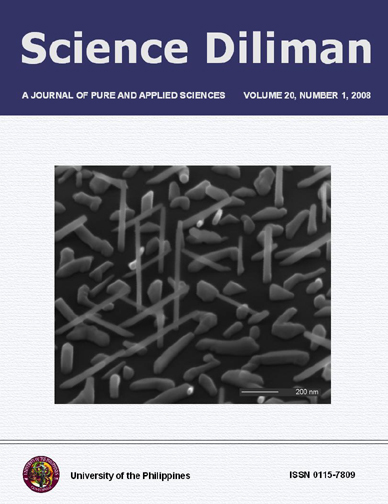Spatial Patterns of Bird Diversity and Abundance in an Urban Tropical Landscape: The University of the Philippines (UP) Diliman Campus
Abstract
An analytical biogeographic analysis of urban bird diversity and abundance was conducted in the University of the Philippines Diliman campus from February to April 2005. Using the Jokimäki urban bird census technique on four different land use subplots we observed 36 species of birds and 4036 cumulative counts individuals of these species. The open field area had the highest number of species (23) while the residential area had the lowest species number (14). The residential area has the highest bird counts and the College of Science complex had the lowest number of counts. Linear regression analysis of landscape features on bird abundances reveals that the number of trees and buildings are most significant predictors of abundances. Spatial features and the trophic characteristics of the bird species are not significant factors to account for abundance. Trees and buildings affect the distribution and abundance of urban exploiting species Passer montanus and Pycnonotus goiavier with the former favoring built spaces and the latter favoring trees. Analysis of species area curves suggests that the bird community of the campus is not homogenized and that certain habitats allow uncommon species to persist. We recommend that in order to increase bird biodiversity existing green spaces must be preserved, fruit trees planted and in areas reserved for building development, pocket gardens and rooftop gardens be included in the landscape architectural design.
Published
2008-11-27
How to Cite
VALLEJO JR., Benjamin et al.
Spatial Patterns of Bird Diversity and Abundance in an Urban Tropical Landscape: The University of the Philippines (UP) Diliman Campus.
Science Diliman: A Journal of Pure and Applied Sciences, [S.l.], v. 20, n. 1, nov. 2008.
ISSN 2012-0818.
Available at: <https://journals.upd.edu.ph/index.php/sciencediliman/article/view/1133>. Date accessed: 01 oct. 2025.
Issue
Section
Articles
Keywords
birds; biogeography; urban ecosystems; University of the Philippines; Metro Manila
Submission of a manuscript implies: that the work described has not been published before (except in the form of an abstract or as part of a published lecture, review, or thesis); that it is not under consideration for publication elsewhere; that its publication has been approved by all co-authors, if any, as well as by the responsible authorities at the institute where the work has been carried out; that, if and when the manuscript is accepted for publication, the authors agree to the automatic transfer of the copyright to the publisher; that the manuscript will not be published elsewhere in any language without the consent of the copyright holders; that written permission of the copyright holder is obtained by the authors for material used from other copyrighted sources; and that any costs associated with obtaining this permission are the authors’ responsibility.



